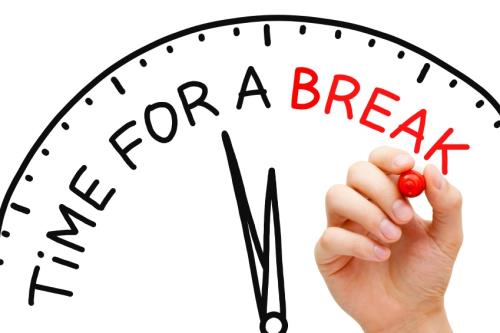 Do you find that your productivity varies from one day to the next? Do you sit down to get stuff done and then next thing you know hours have passed and the most important tasks are still outstanding? Some days I can fly through my tasks fast and then yet other days drag, and I seem to get constantly distracted (often caused by yours truly), leading to a longer “to do” list than when I started! That was until I discovered the simple and effective Pomodoro Technique®.
Do you find that your productivity varies from one day to the next? Do you sit down to get stuff done and then next thing you know hours have passed and the most important tasks are still outstanding? Some days I can fly through my tasks fast and then yet other days drag, and I seem to get constantly distracted (often caused by yours truly), leading to a longer “to do” list than when I started! That was until I discovered the simple and effective Pomodoro Technique®.
Many studies, including a 2014 report from Germany, show that being tied to your desk (sedentary) can have a negative impact on our physical health (obesity, heart disease, cancer, diabetes) and also reduces our work productivity. I always thought that if I did regular yoga and went to a gym class four to five times a week then I would be healthy. However, this recent research shows that long periods of inactivity at our desks can undo all that effort and hard work. Other studies including Australian data on metabolic disorder, show that while exercise is vital for good health, regular breaks from your desk can reduce these health risks and help us keep focused and energized.
That is why this blog focuses on a solution that solves both using the Pomodoro Technique developed by F. Cirillo. I love it because it is simple and benefits two keys drivers of our success: productivity and health. Cirillo named it after the tomato shaped kitchen timer he used to take his own regular 25 minute scheduled breaks. The Pomodoro method is simple and includes the following:
-
Each 25-minute session of focused work = 1 Pomodoro.
-
When you complete 1 Pomodoro, take a 5 minute break before starting the next.
-
When you have completed 4 Pomodori, take a longer break to rest and recharge.
At first, it might seem counter-intuitive to take so many breaks, but research shows that this actually enhances our focus when we return to the task we're working on. In more depth…
1. Prioritize Your Schedule
Your first step is to check your calendar and to-do list to determine priority tasks for the day (see my Important Versus Urgent blog if you need help prioritizing). Estimate how long each task will take to finish in terms of Pomodori (25 minute sessions). Now plan your day to ensure your most important tasks fill your calendar. Next schedule time for your breaks, 5 minutes for each Pomodoro completed, plus a longer 20-30 minute break after 4 Pomodori (for some of us, a Pomodoro work session of 60 minutes can work well).
2. Set Your (Churchill) Timer
Before you start your work, make sure that you have everything you need. Shut your office door, turn off your phone, email and alerts and block your calendar. If you work in an open environment, try to reserve a meeting room or work from home when you really need to focus. Wait until your break to make any calls or check emails. Set your timer for your Pomodoro of choice. (I provide clients with a Churchill cube timer – super easy to use!)
3. Focus Only On The Task At Hand
Devote all of your attention to the task at hand for the duration of the session. Because it is only 25 minutes, it is easier than you think. Don't allow yourself to become distracted if ideas or thoughts about other tasks pop into your head. Write these down on a notepad if you have to so you don’t forget them, but then set the notepad aside. If this notepad list keeps calling your name, you can adjust your schedule to devote your next Pomodoro session to them. If you complete your work before your timer goes off, use the remaining time for other short tasks.
It's a good idea to make a note of how many Pomodori each scheduled regular task takes you, so you can use this for future planning and to measure increased productivity levels as time goes on.
4. Take Short Breaks
When your timer goes off, take your 5 minute break. Be sure to do this even if you are “on a roll” because these regular breaks will restore your energy and improve your productivity to levels that make up for any perceived lost time. Cirillo argues that energy levels are far more important than time, and I agree. The Pomodoro approach works by maintaining your energy, so that you have less wasted time working on tasks when your concentration is low.
For maximum benefit use your breaks to move around. Take a walk, climb the stairs, go and get a glass of water or see a colleague. This regular activity is sufficient to avoid the ill-health issues that arise when your large muscles are inactive for hours upon end.
Alternately, consider doing a 5 minute mediation. But resist using your breaks for social media, email or surfing the web.
5. Continue Your Pomodori Sessions and Take Your Longer Break
After your 5 minute break, reset your (Churchill) timer for the next 25 minute session and continue your focused work. When you've completed 4 Pomodori sessions, take a 20-30 minute break. During this time, go for a walk, get a healthy snack, network or read a book. Consider doing whatever activity gives you the best break from your desk and that clears your mind. Listen to your body. If your mind starts to wander or you start to feel tired, don't push through to the end of the session. Your body rhythms naturally follow 90- to 120-minute cycles, and it's hard to know what stage of your rhythm you were at when you began your task. Listen to your body.
Experiment using the Pomodoro technique to see if it works better for you in the morning or afternoon (or both!). Once you have found your ideal pattern you will be amazed at what you can achieve in a working day.
Still not sure if this technique will work? Then consider these benefits of the Pomodoro Technique:
-
Allows you to do highly focused work and makes large projects seem less overwhelming.
-
Minimizes distractions, multitasking and procrastination, which therefore increases your productivity.
-
Regular short breaks are good for your health and concentration (Cirillo says it is also good for ADD).
-
Short breaks allow your mind to assimilate information leading to greater ideas and innovation.
Remember this simple technique could have big benefits for both your productivity and your health. Frequent breaks enhance your ability to concentrate on a task, which improves productivity. They also help your body fight the negative effects of prolonged periods of physical inactivity from sitting at your desk.
Remember, as with trying anything new, you need to give it a chance and not give up right away. I hope you find that this approach provides you value that I have gained. Stay strong!
 Written by Jayne Jenkins, CEO Churchill Leadership Group-Jayne is a Fortune 500 Leadership business veteran working for some of the largest companies in the world including Exxon, AstraZeneca and Sanofi. For over 23 years, Jayne refined her team development and leadership capabilities and built finely-tuned sales teams, responsible for delivering annual sales over $600M. Through her effective leadership and collaboration, Jayne and her team took market share of a $4Bn business unit from 32 to 41% in just four years. Jayne has also been successful in Marketing, Strategic Operations and Organization Development, so she understands many key business areas. Jayne founded Churchill Leadership Group, an Executive Consulting and Coaching Company. Churchill’s mission is to increase organizational effectiveness by growing leadership skills and employee engagement through a focus on STRENGTHS for sustainable results. This enables corporate teams, across industries, to enjoy outstanding results. Jayne worked with Marcus Buckingham, renowned author/STRENGTHS expert (Now Discover Your Strengths/First Break All the Rules/STAND OUT), and his team to become a “Master Strengths Coach and Workshop Facilitator.”
Written by Jayne Jenkins, CEO Churchill Leadership Group-Jayne is a Fortune 500 Leadership business veteran working for some of the largest companies in the world including Exxon, AstraZeneca and Sanofi. For over 23 years, Jayne refined her team development and leadership capabilities and built finely-tuned sales teams, responsible for delivering annual sales over $600M. Through her effective leadership and collaboration, Jayne and her team took market share of a $4Bn business unit from 32 to 41% in just four years. Jayne has also been successful in Marketing, Strategic Operations and Organization Development, so she understands many key business areas. Jayne founded Churchill Leadership Group, an Executive Consulting and Coaching Company. Churchill’s mission is to increase organizational effectiveness by growing leadership skills and employee engagement through a focus on STRENGTHS for sustainable results. This enables corporate teams, across industries, to enjoy outstanding results. Jayne worked with Marcus Buckingham, renowned author/STRENGTHS expert (Now Discover Your Strengths/First Break All the Rules/STAND OUT), and his team to become a “Master Strengths Coach and Workshop Facilitator.”
Do you have a question for Jayne? Post it in our Senior Manager Community and she will be happy to help: Ask an Expert
Did you find this article informative? Let us keep you up-to-date on all of our training articles. Please sign up for our newsletter today!
Here are some related articles you may be interested in:
Managing Conflict: Six Things NOT to Do
Lost in Translation, Again!
Why is Talent Management Important in 2014? Part 1
Why is Talent Management Important in 2014? Part 2
Leading Through Change: Persistence and change agents are vital!
About ManagingAmericans.com
We are America’s Management & Leadership Center for Professional Development. Our well-rounded business content is designed for Leaders & Managers to implement change with ease & improve accountability amongst their teams. Here you’ll find Articles from 30+ Expert Consultants, Coaches & Thought Leaders, access practical Business Templates, learn new skills & connect to our Expert Panel to answer your organizational challenges.